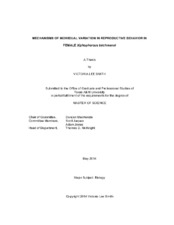| dc.description.abstract | Mate choice is a powerful driver of sexual selection, and can influence both the strength and direction of selection on phenotypic traits within a population. In Xiphophorus birchmanni, female mate preferences have been extensively characterized. The majority of studies in this species have focused on documenting a mean value for female mate preference within a population. Despite the rich history of mate choice research in this genus and the apparent importance of studying mechanisms of female mate choice for understanding sexual selection processes, no studies to-date have investigated the hormonal mechanisms that underlie female mate choice behavior in
this species. Because of its role in reproductive processes across taxa, cortisol was selected as a candidate hormone for involvement in the modulation of reproductive behavior. To establish baseline cortisol values and evaluate possible relationships between cortisol and reproductive activity in this viviparous species, I first evaluated consistency and repeatability of reproductive behavior and water-borne cortisol levels in captive X. birchmanni over six days of repeated mate choice testing. Repeatability and consistency of mate preferences were low, with low volume water sampling for cortisol appearing to be a potential stressor. To determine if repeated sampling could reduce
sampling stress, I collected water from females placed in larger volume collection beakers over 4 consecutive days. Water-borne cortisol levels decreased over the sampling period, suggesting habituation to the repeated sampling procedure. Although cortisol values fell within the range of other poeciliid fishes, data indicated that plasma and water-borne cortisol levels were not correlated in this species. Finally, to determine if a relationship existed between circulating cortisol levels and reproductive status in a wild population of X. birchmanni I collected plasma and ovarian samples from wild caught females and correlated reproductive status with plasma cortisol levels. I found that cortisol levels vary with reproductive status. Although samples sizes were small, cortisol was elevated during gestation, a pattern similar to guppies and progesterone in mammals. Results suggested that cortisol may play a role in pregnancy and reproductive behavior in the species and that if water-borne hormone sampling could be validated, this species might serve as a useful model system for teleost behavioral endocrinology. | en |


